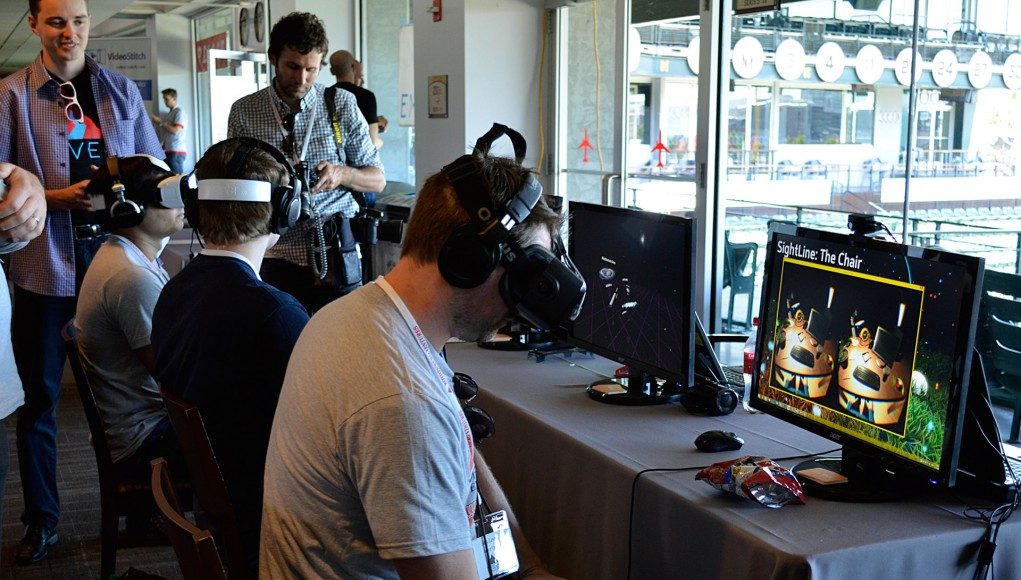The first class of Rothenberg Ventures’ ‘River’ VR accelerator have graduated. Thirteen companies, in which Rothenberg invested a combined $1.3 million, showed off their latest work at the company’s annual Founder Field Day event. Road to VR was on the scene to see what the companies had accomplished during the three month accelerator.
In December last year, Rothenberg Ventures, a venture capital firm based in San Francisco, announced plans for the first all-VR accelerator program that they call ‘River‘. The company sought to invest $1 million across 10 virtual reality startups. The three month program would provide office space and regular mentorship from knowledgeable advisors. After sifting through some 200 applicants, Rothenberg Ventures ultimately raised their ante to $1.3 million across 13 companies for the first River class.
The culmination of that first class came at Founder Field Day, an annual event hosted by Rothenberg Ventures that brings together founders, investors, strategists, and mentors for a day of networking and learning. The focal point of the event, held in San Francisco at the home of the Giants, AT&T Park, was the 13 graduating River companies. I got to speak with the founders of these VR companies and see what they’d achieved after three months in the River program. Part Two of this three-part series features Psious, Deepstream VR, Solirax, and Discovr.
See Also:
- Part One – Reload Studios, Totwise, Innerspace, and Emblematic Group
- Part Three – Fove, Triggar VR, and Vantage.TV
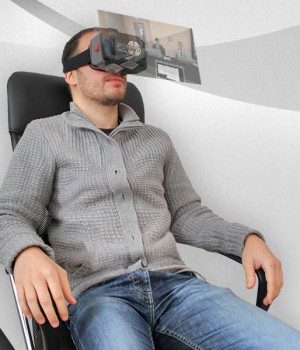
11 Psious
The Psious Toolkit is a web-based portal that will allow professionals to customize anxiety therapy experiences for their patients to then be viewed through a VR smartphone adapter. Once the patient is in the experience, the professional can make adjustments on the fly and record patient observations of individual sessions, allowing changes in anxiety levels to be seen over time.
Unfortunately, one of the company’s biggest strengths (targeting the smartphone VR adapter for a low barrier to entry) may turn out to be one of their biggest uncontrollable variables, with smartphone-based VR lacking significantly in power and performance compared to headsets containing dedicated hardware. Google is hard at work improving performance of the smartphone VR ecosystem, but the experience gap is still substantial.
On the bright side, Psious’ approach to VR-enhanced therapy is supported by proper research. Published in the official journal of the Anxiety and Depression Association of America in 2011, a meta-analysis of research surrounding Virtual Reality Exposure Therapy (VRET) finds the following trends:
- VRET does far better than the waitlist control
- Post-treatment results show similar efficacy between the behavioral and the cognitive behavioral interventions incorporating a virtual reality exposure component and the classical evidence-based interventions, with no virtual reality exposure component
- VRET has a powerful real-life impact, similar to that of the classical evidence-based treatments
- VRET has a good stability of results over time, similar to that of the classical evidence-based treatments
- There is a dose–response relationship for VRET
- There is no difference in the dropout rate between the virtual reality exposure and the in vivo exposure
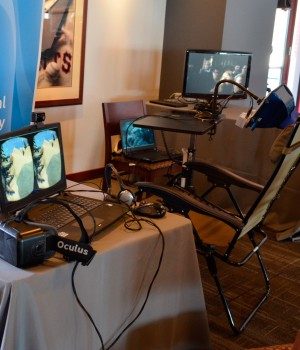
22 Deepstream VR
VR isn’t new to the healthcare field, but it’s mostly been an expensive tool used by doctors for training, rather than patients. Now that the wave of consumer VR is bringing headsets and content at affordable price points, the door opens for deploying such systems wherever they might find use.
Pain management, says Rose, is one area that can benefit with the use of VR. The path to recovery for patients with significant injuries is wrought with episodes of pain, from bandage changing of burn victims to physical therapy for those with broken bones.
A series of academic studies listed on Deepstream’s VR Pain Control Research page finds that VR can not only enhance results when combined with pain medication (thereby reducing the amount of pain control substance needed), but can even function to reduce pain when used alone with no medicine at all. It turns out that distracting patients during episodes of pain can also distract them from the pain itself; VR can be particularly effective at distraction thanks to its ability to immerse users.
“All pain ratings for all pain measures were significantly lower during VR than in the control condition,” found a 2000 study published in the Clinical Journal of Pain.
Beyond pain, VR has the potential to make life in hospitals better for long term patients. Rose tells the story of recovering children who can be confined to a hospital for upwards of a year at a time. Virtual reality can open the door to worlds anew for playing, learning, and even social stimulation while patients are stuck in the hospital.
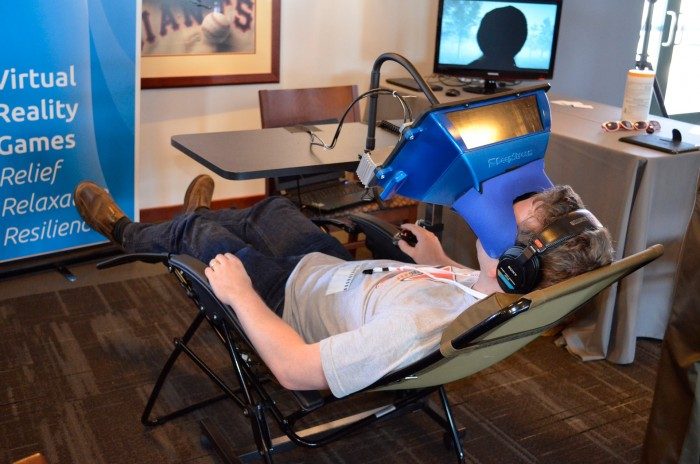
Deepstream is currently demo’ing healthcare experiences on their custom-made Deepstream 3D Viewer, a special hood with lenses that adapts a laptop or tablet into a 3D-capable display, as well as consumer VR technology like the Oculus Rift.
While not as immersive due to a small field of view and lack of headtracking, the Deepstream 3D Viewer is used without a head mount, making it ideal for patients who would benefit from a contactless experience and one that doesn’t require head movement.
The experience demonstrated at Founder Field Day had players floating down a stream (probably a deep one at that), able to aim at flying targets and fire balls to strike them for points. Each target could be hit twice, with a small cooldown between, encouraging players to keep searching for targets while the others refreshed. Targets were scattered around the environment and become more dense as the level progressed, taking players down falls and through caves along an arctic environment. The ultimate goal, of course was to eliminate as many targets as possible.
While demoing the game, Deepstream was running an unscientific test to see how long players were comfortable with their hand in ice water, both in and out of VR. Although subjectively I felt like the pain from the ice water was less of a concern while playing the Deepstream experience, the knowledge of what the test was supposed to do likely influenced my experience greatly. While research indicates that VR is effective for pain management, it will be interesting to see a properly conducted study which tests the results of Deepstream’s game in particular.
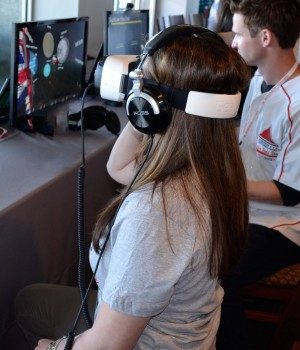
33 Solirax
In addition to experimentation with light-fields for VR, Solirax is currently developing NeoS VR, an educational VR platform that will allow users to see and interact with educational experiences.
Currently in development as a technical demonstration of the platform is NeoS: The Universe, a ‘Power of 10’ experience that takes viewers from the smallest elementary particles to the largest structures of the universe. Folks of the internet era may be familiar with such experiences thanks to Cary Huang’s popular Scale of the Universe, but the concept has been depicted for some time.
Solirax is building NeoS: The Universe for Samsung’s Gear VR as a submission to the Oculus Mobile VR Jam. I got to try an early build of the experience. As I donned the Gear VR, around me was darkness and a white line which represented an infinitesimally small unit of measure. Here I was greeted with the smallest fundamental particles. A narrator spoke about how the universe is governed by four fundamental forces: gravitational, electromagnetic, strong nuclear, and weak nuclear.
As the first unit of measure scaled down in size, a new one came into view, representing a size that’s 10 times larger than the first. As this scale progressed, larger particles came into view along with wavelengths of different colors of light. Eventually I made it up to the human scale where I saw familiar objects like baseballs and basketballs. Beyond this came cars, buses, buildings, mountains, and so on. From there I quickly reached the size of countries, moons, and planets, followed by a series of exceedingly large stars. This progression zoomed me all the way out to the extent of the observable universe.
As a fan of science and space, I naturally found this to be a really awesome way to convey the incredible variations in scale that exist in this universe, and even a lesson on the power of exponential numbers.
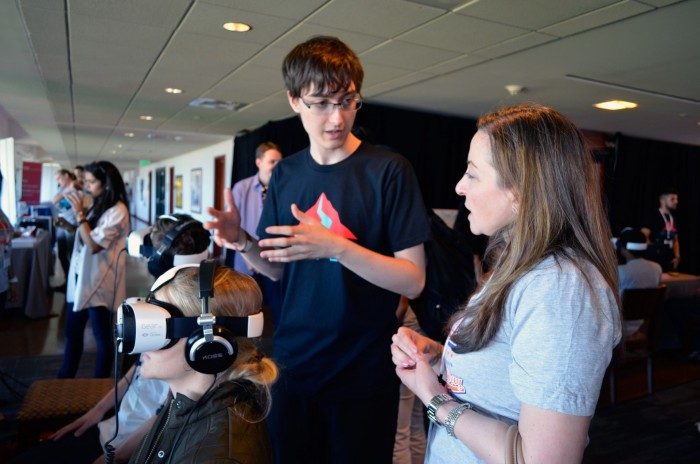
While you might think that it would be impossible to adequately fill the space from the smallest particles to the largest parts of the universe, feedback from my experience was actually that there were too many objects shown! It was difficult to focus on them all as they zoomed by on my way to the next power of 10. For Solirax’s continued development, I suggested paring down the number of objects so that the user has more time to examine each one. I also suggested allowing the user to control the speed and direction of their journey, which Mariančík told me was already high on his list of forthcoming features.
When I was younger I got to see a great ‘Powers of 10’ rendition narrated by Morgan Freeman, and it has stuck with me ever since. If companies like Solirax succeed, the children of tomorrow are going to have unbelievably immersive educational experiences that completely blow away what’s come before.
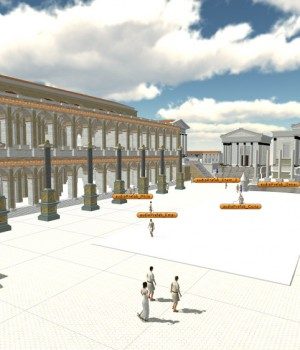
44 Discovr
From possible but impractical trips—like taking a U.S. class to rome—to the impossible—a trip inside the human body—Discovr envisions itself as a creator of VR content that will educate and enrich.
In early 2014, Discovr raised a small pot of funding, some $2300 worth, on Kickstarter to create Vessels, an educational VR experience that would tour students around the inner workings of the human body.
Now with funding from the River program, Discovr is working on several new experiences, including a virtual trip to ancient Rome and a brain skill testing game which challenges users’ spatial memory skills in a series of mini-games.
The ancient Rome experience is currently a very early prototype, but it shows the sort of functionality that the team hopes to deliver. Running on Gear VR, I was dropped into a rudimentary recreation of an ancient Roman plaza, with columned buildings and free-standing columns delineating the open courtyard.
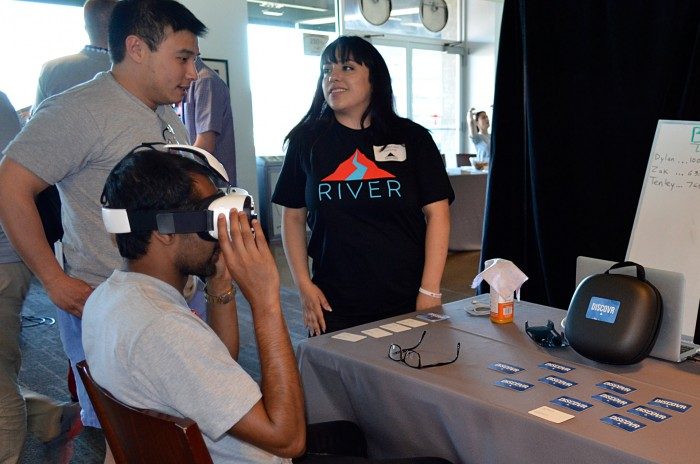
The streets were filled with models of Romans roaming about. You can walk up to those hanging out in the plaza to listen in on a conversation, which is filled with hints about the history of this particular moment in ancient Rome. If you approach certain buildings, you’ll hear dialogue explaining further about the building’s history and purpose.
Just like textbooks, educational VR content needs to be authored, which means that a company like Discovr could become as well known in the education space as McGraw-Hill or Pearson.
Disclosure: Rothenberg Ventures covered Road to VR’s travel costs to attend Founder Field Day.

